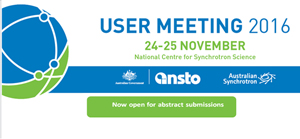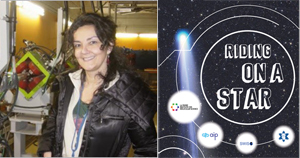- Details
Whether you’re a synchrotron star keen for the latest technical updates or a student ready to sell your science in the Poster Slam, User Meeting 2016 has something for everyone. Showcasing the best research undertaken at the Australian Synchrotron and featuring local and international plenary speakers, User Meeting 2016 will provide updates on cutting-edge technique and application developments over a two-day program featuring themes and sessions on advanced materials, biological systems, structural biology, earth and environment, therapies, surfaces, industry and imaging.
We’re open for registrations and now calling for abstract submissions.
For more information, visit: Australian Synchrotron User Meeting 2016
- Details

Lloyd Rees Memorial Lecture by Professor Keith Nugent
Thursday 6 October, 2016 at 2.30 pm at the Wark Theatre at CSIRO Manufacturing
Sources of the energetic form of light known as X-rays are developing at an enormous rate. Indeed, by one measure, they are improving at a rate that exceeds computing’s famous Moore’s Law.
The rapid improvement of synchrotron sources has driven a very significant part of this growth over the last few decades, but the already dizzying rate of development has recently been accelerated by the construction of X-Ray Free Electron Lasers (XFELS), with the first beginning operation in the USA in 2011. XFELS are now either operating or under construction in a number of countries around the world.
XFELS are based on linear accelerator technology and are able to produce pulses of X-Rays that can be up to ten orders of magnitude brighter than the pulses from modern synchrotrons. This extraordinary growth in capability is certain to unlock new scientific insights and new technologies. In this talk, Professor Nugent will describe the physics underpinning X-Ray Free Electron Lasers. He will go on to outline some of the scientific drivers behind the significant global investment in X-Ray lasers, with the most important being the possibility of imaging a single biomolecule. He will describe his progress towards these scientific goals.
Light refreshments available after the Lecture.
About the speaker
Professor Keith Nugent FAA is internationally recognised for his outstanding contributions to Chemical Physics. As Director of the ARC Centre of Excellence for Coherent X-Ray Science from 2005 to 2013 he has driven the development of coherent X-Ray diffraction methods for imaging biological structures. His other important contribution to Chemical Physics focuses on the complete recovery of phase from intensity and the applications of this to imaging
- Details
We are all on an inescapable journey through the universe with our nearest star: our sun. If our kind manages to survive for hundreds or thousands of millions of years, we are in for one a hell of a ride.
On Thursday 25 August, join researcher in fundamental physics from the DAFNE collider in Frascati Italy, Dr Catalina Curceanu, on an imaginary journey through space and time: Riding on a star – this year’s Victorian Women in Physics lecture.
- Discover how stars work
- Find out what keeps stars alive and what happens when they die
- See how a star can become an impressive supernova and give birth to a neutron star
- Wonder the forces that bring about black holes …
- and ponder an important question for our distant descendants: How will our own meet its end?
The Victorian Women in Physics lecture celebrates the contribution of women to advances in physics; this year it is hosted by La Trobe Institute for Molecular Sciences.
For more information visit the Australian Institute of Physics.


